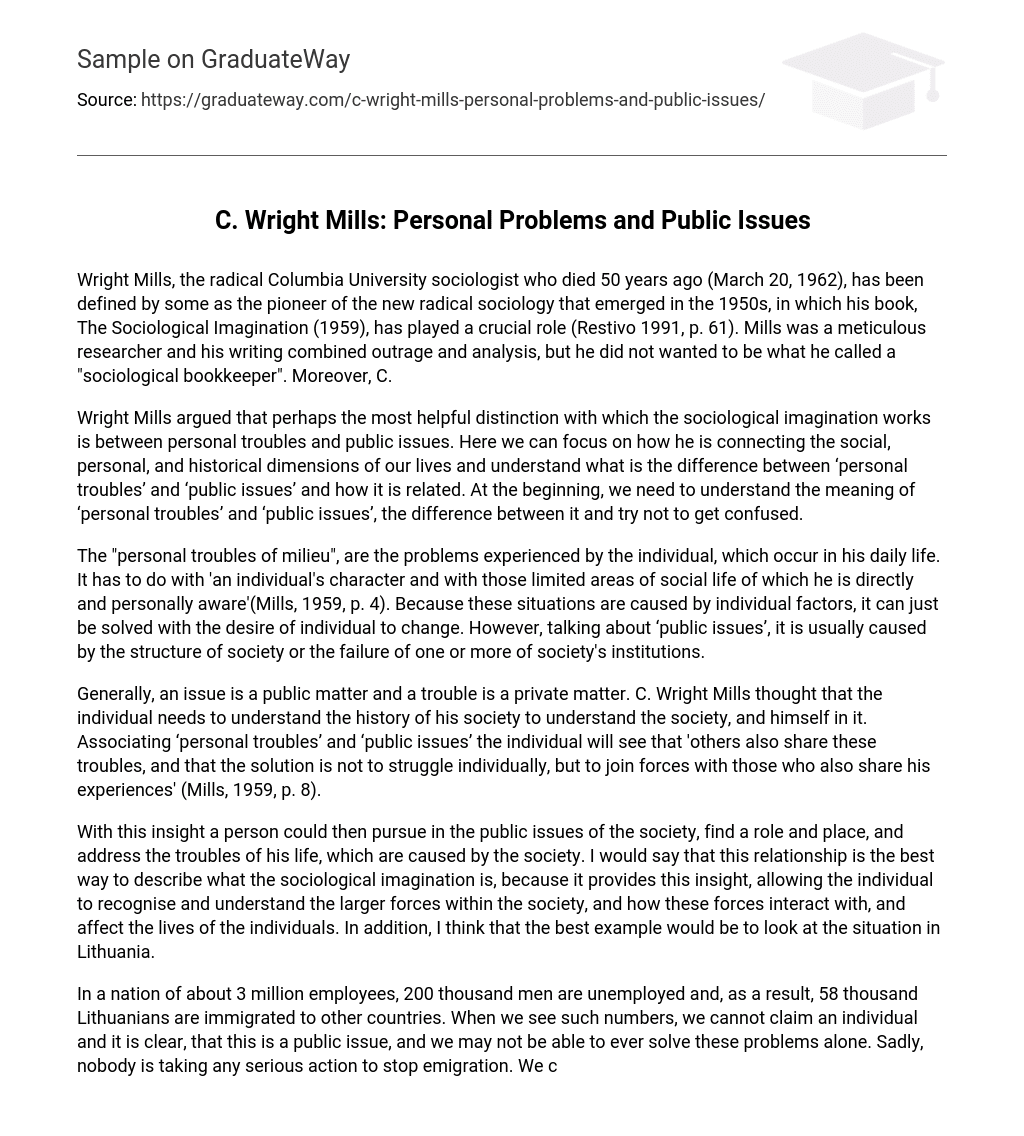Wright Mills, the radical Columbia University sociologist who died 50 years ago (March 20, 1962), has been defined by some as the pioneer of the new radical sociology that emerged in the 1950s, in which his book, The Sociological Imagination (1959), has played a crucial role (Restivo 1991, p. 61). Mills was a meticulous researcher and his writing combined outrage and analysis, but he did not wanted to be what he called a “sociological bookkeeper”. Moreover, C.
Wright Mills argued that perhaps the most helpful distinction with which the sociological imagination works is between personal troubles and public issues. Here we can focus on how he is connecting the social, personal, and historical dimensions of our lives and understand what is the difference between ‘personal troubles’ and ‘public issues’ and how it is related. At the beginning, we need to understand the meaning of ‘personal troubles’ and ‘public issues’, the difference between it and try not to get confused.
The “personal troubles of milieu”, are the problems experienced by the individual, which occur in his daily life. It has to do with ‘an individual’s character and with those limited areas of social life of which he is directly and personally aware'(Mills, 1959, p. 4). Because these situations are caused by individual factors, it can just be solved with the desire of individual to change. However, talking about ‘public issues’, it is usually caused by the structure of society or the failure of one or more of society’s institutions.
Generally, an issue is a public matter and a trouble is a private matter. C. Wright Mills thought that the individual needs to understand the history of his society to understand the society, and himself in it. Associating ‘personal troubles’ and ‘public issues’ the individual will see that ‘others also share these troubles, and that the solution is not to struggle individually, but to join forces with those who also share his experiences’ (Mills, 1959, p. 8).
With this insight a person could then pursue in the public issues of the society, find a role and place, and address the troubles of his life, which are caused by the society. I would say that this relationship is the best way to describe what the sociological imagination is, because it provides this insight, allowing the individual to recognise and understand the larger forces within the society, and how these forces interact with, and affect the lives of the individuals. In addition, I think that the best example would be to look at the situation in Lithuania.
In a nation of about 3 million employees, 200 thousand men are unemployed and, as a result, 58 thousand Lithuanians are immigrated to other countries. When we see such numbers, we cannot claim an individual and it is clear, that this is a public issue, and we may not be able to ever solve these problems alone. Sadly, nobody is taking any serious action to stop emigration. We can easily find the main reason by looking Lithuanian history. During the World War II, it was occupied by the Soviet Union for more than 50 years, all political, economic, and cultural life was controlled.
Children were grown with fear, there was no free will and all borders were closed. If you were not happy with the situation, there was two ways – to keep quiet or to be deported. I would say that even now, in independent country, citizens are scared to take actions and do not see any solutions, they just choose the easiest ways – run away from problems or keep quiet. Hopefully, the new generation, who is born in independent and democratic country, might take some actions to ensure a better life for their children.
In conclusion, without a sociological imagination the individual is unable to see that most of his troubles are caused by the structure of society and he cannot become involved in the question of moral values of his community. We must ‘know that the problems of social science, when adequately formulated, must include both troubles and issues, both biography and history, and the range of their intricate relations. Within that range the life of the individual and the making of societies occur; and within that range the sociological imagination has its chance to make a difference in the quality of human life in our time’ (Mills, 1959, p. 26)
Words: 724 References 1. Kathryn Mills with Patricia Mills, editors, “C. Wright Mills: Letters and Autobiographical Writings,”, (2000), first chapter. 2. C Wright Mills, (1959), “The Sociological Imagination”, first and last chapters. 3. Sal Restivo” The Sociological Worldview” (1991) , first chapter. 4. http://www. cwrightmills. org/ – 16:0516/10/2012 5. http://www. bernardinai. lt/straipsnis/2012-01-09-statistikos-departamentas-lietuvos-gyventoju-sumazejo-taciau-padidejo-sugrizusiu-emigrantu-skaicius/75055 18:15 16/10/2012





